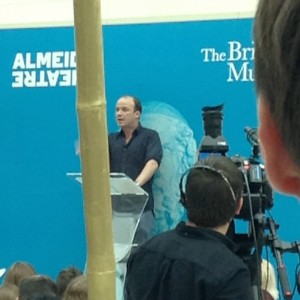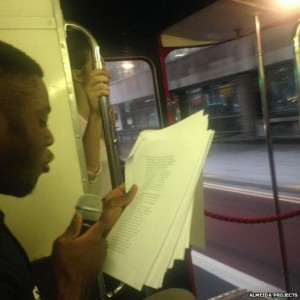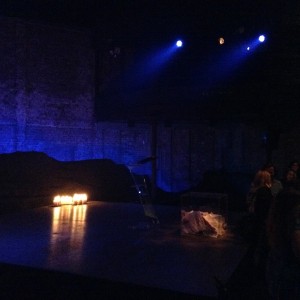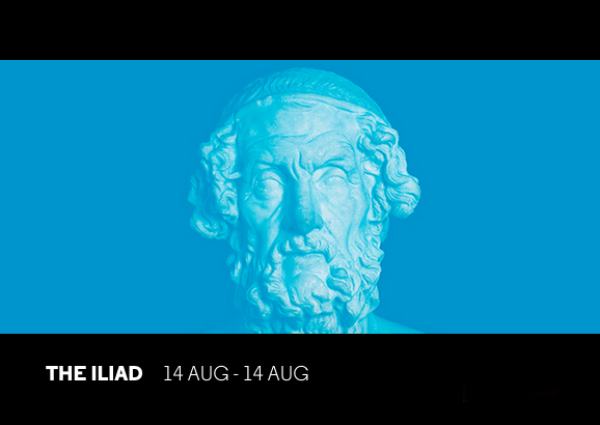This week’s postcard comes to you from the British Museum, home of the score of Handel’s Messiah and the world’s oldest known chess set and the ever-contentious Elgin Marbles. But I wasn’t there to see any of these wonderful displays. I was there because I was in exactly the right place at precisely the right time in order to catch a once-in-a-lifetime event.
You see, the Almeida Theatre in Islington (North-central London for those of you who like to know these things) has declared this summer The Greek Season, and is staging all new productions of ancient Greek classics, from Medea to Orestes, and making headline all the while. For those of you interested in learning more, click here. And because the Almeida believes not only in launching new performers’ careers, but in touching as many people as possible with what they do, they arranged to have a public reading of Homer’s The Iliad. In the main entrance hall of the British Museum. With over 60 actors and actresses taking part.
Now, I had read The Odyssey in high school, and I remembered being quite pleasantly surprised by how much I enjoyed the story, how engaged I was in the drama and characters, and how accessible the story remained, even after some 2,700 years. I went to the Museum, knitting project in hand, expecting a fun performance, but nothing could have prepared me for this performance of The Iliad.
The Trojan War kicked off at 9am, with fearless Hector and passionate Achilles battling for honor and glory, all watched by the ever-present and ever-meddlesome gods of Olympus. Those of us sitting on the benches in the atrium of the museum heard performances from the likes of Rory Kinnear (see my lousy photo below), Sinéad Cusack and Sherlock‘s Mark Gatiss, as well as Outlander‘s Tobias Menzies, whose performance of Hector’s death was utterly spellbinding, and, be still my heart, Bertie Carvel, of Jonathan Strange and Mr. Norrell fame. But while the chance to hear performances from such acclaimed actors was thrilling, what happened that day was far bigger than any one person.

According to news reports, there were several hundred people listening to The Iliad at any given point during the day at the Museum. And thousands of others streamed it online, thanks to the Almeida’s 16-hour internet broadcast. And enough people tweeted about the event to make #iliad one of the top ten trending hashtags in the world. For any book to make such an impact is impressive, but it speaks even more highly of The Iliad–and Robert Fagles’ phenomenally accessible and sympathetic translation–to realize that the work getting all this attention was nearly 3,000 years old.
All the works attributed to the person (or people) known as Homer were meant to be read out loud, a fact immediately apparent to those of us listening. There is something truly magical about having a story read to you, and the act of sharing tales is a fundamental and moving human interaction that shouldn’t be limited to our childhoods. No one in that Museum was too sophisticated or too old to be drawn into this timeless epic, or the energy of those who brought it to life. Some people brought battered paperback copies of The Iliad with them in order to follow along. Others spread out their coats and had a make-shift picnic in the lobby of the museum. I found a few other knitters there, and we formed what one production assistant named “Madame LaFarge’s corner”. Others simply heard the cadence of a story unfolding and stopped….and stayed to cheer the passionate speeches from Agamemnon, or revel in the gory details of ancient battles. When Hector killed Petroclus, one little boy who had been sitting near the podium audibly gasped.

Now, at over 2,700 lines, The Iliad remains one of the longest poems ever written, and even starting at 9:00am and going non-stop, with actor’s reading for some 15-25 minutes a piece, by the time the British Museum was about to close, we had only made it through about 2/3 of the book. So The Iliad moved to the Almeida for a nighttime marathon…and Marco Brondon reading his passage out loud on the bus in order to ensure the marathon would not stop.

At 8pm precisely, once everyone had made the pilgrimage from the Museum to the Almeida, The Iliad began again, with the battle over Patroclus’ body raging, and Achilles’ growing fury turning into a killing rage. Each performer dropped their script into a huge clear box when they were finished, allowing the audience to realize how much we had collectively accomplished. The candles on the stage burned lower as the tale progressed, creating longer and longer shadows along the brick walls. People read along, stretched out in the seats, leant forward in rapt attention, and applauded as each storyteller dropped their part into the box and made way for the next section of text. Five hours later, at 1:01am, we collectively buried Hector, the Breaker of Horses, and called an end to one of the most remarkable days I can remember.

I don’t know how to describe this whole event to you adequately–the energy and excitement that swirled over a book that had been read out loud, the pure joy that the performers and audience took in each section of text, even after 16 hours. And when the final line was read, everyone stood and cheered, knowing they had been a part of something unforgettable.
There is talk of making this 16-hour performance into a broadcast or podcast, and if I can get any news on that, I’ll be sure to pass it on. For now, here are some clips from the evening at the Almeida for you to savor: Clip 1 & Clip 2. I so wish you had been there, but I hope this makes you feel like you were.

